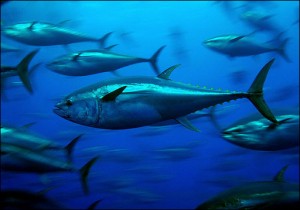By Raju Chebium
Gannett Washington Bureau
The National Oceanic and Atmospheric Administration has received more than 180,000 comments in recent months seeking stronger protections for bluefin tuna, including a ban on longline fishing in the Gulf.
[/information]The agency is revising its fishery management plan for migratory species and expects to announce a new strategy in 2014.
“Commercial fishermen in the Gulf of Mexico use surface longlines that average 30 miles long to catch yellowfin tuna and swordfish, but this indiscriminate and wasteful fishing method also catches and kills more than 80 types of non-target animals, including … deeply depleted Atlantic bluefin tuna,” Tony Murray, director of the Big Bend Coastal Conservancy in St. Marks wrote to NOAA.
Longline fleets drop large baited hooks to catch big fish. Hundreds of strong hooks are attached to fishing lines that branch out from a main line that is miles long. All the lines are held afloat by buoys. Though fishing for bluefin tuna is banned in the Gulf, they get caught in the hooks and are unable to break free.
The lines also snag other “bycatch,” including turtles, sharks and marlin. But conservationists and recreational fishermen focus on bluefin tuna because the species is declining and is especially prized by sushi lovers.
They say longline fleets could switch to other fishing methods to catch yellowfin tuna and swordfish, which have rebounded to healthy levels. Those species are smaller and lighter than bluefin tuna, which can grow to 13 feet and weigh two tons.
The federal government restricts the annual bluefin tuna catch to 2.07 million pounds for commercial and recreational fishermen combined.
Federal rules allow fishermen to keep a limited number of bluefin tuna and toss back fish that exceed the quota. The number varies according to a formula that takes into account how much of the quota has been met. Each recreational fisherman is generally restricted to three bluefin tuna a day. [Read More]



